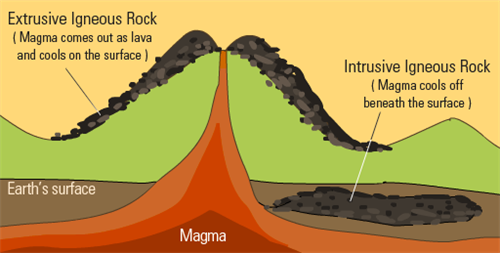
PUMPA - SMART LEARNING
எங்கள் ஆசிரியர்களுடன் 1-ஆன்-1 ஆலோசனை நேரத்தைப் பெறுங்கள். டாப்பர் ஆவதற்கு நாங்கள் பயிற்சி அளிப்போம்
Book Free DemoRocks formed as a result of cooling, solidification and crystallisation of molten magma (molten rock within the earth surface) and lava (molten rock when erupted) are known as Igneous rocks. These are the first rocks that originated during the formation of the earth’s upper crust. Henceforth, they are known as ‘Primary or Parent rocks’.
Characteristics:
- They are found in volcanic zones.
- The igneous rocks are hard, crystalline and impermeable in nature.
- They do not have strata and fossils.
Based on the mode of occurrence, the igneous rocks are further classified into two types:
- Intrusive Igneous rocks
- Extrusive Igneous rocks

Intrusive Igneous rocks are formed when the molten magmas do not reach the earth surface during volcanic activity; instead, they get cooled and solidified below the earth’s surface.
When the cooling and solidification of magma happens at greater depths from the earth’s surface, Plutonic igneous rocks are formed. The process of cooling is very slow, and the grains are formed. Crystals are also developed because of the slow cooling process, and they are also called ‘ Crystalline rocks’. When the molten magma gets cooled and solidified near the earth’s surface, Hypabyssal igneous rocks are formed. Granite, Gabbro and Pegmatite are examples of Intrusive Igneous rock type.


Extrusive Igneous rocks are formed when the molten magma cooled and solidified at the earth’s surface. These rocks do not form crystals since the cooling rate is rapid. And, these are fine-grained and glassy in texture. Pumice, Obsidian and basalt are representative examples of this type.


Reference:
https://eschooltoday.com/rocks/what-are-igneous-rocks.html
https://geology.com/rocks/igneous-rocks.shtml